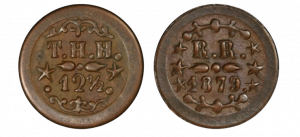Say Aloha to Hawaii Plantation Tokens
Posted on — 2 CommentsIf you’ve ever visited the balmy islands of Hawaii, you may have seen a sugar or pineapple plantation during your travels. Just like the “territorial” gold you may be familiar with struck by private minters in California, Oregon, Utah and Colorado, there is a charming subset of territorial coinage known as Hawaiian plantation tokens.
From 1860-1891, plantation tokens were struck for use in company stores on some of the well-known and large Hawaiian plantations. All Hawaiian plantation tokens are rare and highly sought-after today.
The Hawaiian Islands boast a rich and storied history. It was 1778 when British explorer Captain James Cook landed on the Hawaiian Islands. Indigenous Hawaiians had been living on the islands for over 1,000 years, yet there was no established monetary system there.
Hawaiians relied on Cowry shells, certain types of feathers and even sandalwood to use as money before the British arrived. However, in the years that followed, the British and sailors from other countries brought their native currency including British Sovereigns, Dutch Guilders, Spanish Escudos and these were introduced for use in commerce on the Hawaiian Islands.
Hawaii was an agrarian economy dominated by booming activity at sugar cane, pineapple and coffee plantations. In order to fill the currency void, the plantations created tokens from 1860-1891 that could be used as cash at their company stores. Many of these tokens were made in Maui by blacksmiths and were paid to plantation workers. While the plantation tokens were not legal tender, they did circulate as money throughout the Hawaiian Islands in the late 1800s
The exception appears to be the Waterhouse tokens, which were likely created as advertising pieces since they held no value at his stores.
Various tokens issued by several plantations included the Wailuku, Thomas Horton, Waterhouse and Haiku. These Hawaiian tokens are well-known within the advanced numismatic community and remain highly sought after by collectors today.
Want to read more? Subscribe to the Blanchard Newsletter and get our tales from the vault, our favorite stories from around the world, and the latest tangible assets news delivered to your inbox weekly.
2 thoughts on “Say Aloha to Hawaii Plantation Tokens”
Comments are closed.








Where can I find some of these coins?
Hi Richard:
If you’re looking for something specific, give us a call! We’re happy to help you find the coins you’re interested in.